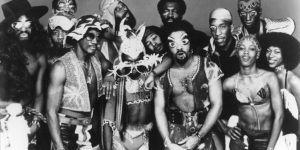CRAM SESSION: An intro to twin pop trailblazers Tegan and Sara
by Cam Lindsay
June 3, 2016
How Calgary's Tegan and Sara transformed from teen angst filled folkies to pop’s greatest duo.
Unless you’ve been following them since the beginning, it’s pretty easy to forget that Tegan and Sara Quin have been operating as a band for more than 20 years.
The Calgarian twin sisters originally formed as Sara and Tegan back in 1995 when they were only 15 years old. They were so self-made and DIY that early on they toured using the Greyhound bus and used their school’s recording studio to lay down tracks for their first two self-releases. But all of their hard work paid off and with each and every release the duo developed a fanbase that has become pretty fucking hardcore.
It shouldn’t have come as a surprise: Tegan and Sara were unique in virtually every way. They were identical twin sisters who wrote and performed (their own) intensely melodic and relatable songs, and knew how to grow as artists in an unforgiving music industry that would always be working against them.
Tegan and Sara have been legit stars for a number of years now, but the path they took almost feels backwards in a way. They began making the kind of indie folk that tends to skew older, and only when they reached their 30s did they begin to make the kind of glossy pop music often reserved for teenagers. One thing hasn’t changed about their music though: no matter how many synths have been layered on top of their new songs, you can still strip them down and perform them with a guitar or recorder or even a kazoo, because Tegan and Sara are just damn good songwriters.
(For what it’s worth, they’re also LGBTQ ambassadors, style icons, and amateur comedians who joke about being style icons.)
As their bio boasts, “This is a band that can perform comfortably alongside Katy Perry or Neil Young, Taylor Swift or The Killers.” That’s really just the tip of the iceberg. They’ve also toured with Lady Gaga, Weezer, Ryan Adams, Death Cab For Cutie, Rufus Wainwright, Paramore, Cyndi Lauper, and The Courtneys. They’ve had their songs covered by the White Stripes and Matt Sharp (Weezer, The Rentals) with actress Maya Rudolph. They’ve been the subject of a NOFX song – a distinction in its own right – called “Creeping Out Sara.” They’ve sung on tracks by Against Me!, Matthew Dear, Theophilus London, Margaret Cho, David Guetta, Fucked Up, and fucking Tiësto.
Of course, Tegan and Sara’s biggest and best collaboration came with the Lonely Island on “Everything Is Awesome,” which they performed at the Oscars with Questlove, Mark Mothersbaugh, and a giant possum. But maybe their greatest accomplishment is becoming the only human beings who will ever get nominated for the Polaris Music Prize, an Oscar, a Juno, a Grammy, a GLAAD, and the highly sought after YTV Award.
In honour of their new album, Love You To Death, we took a look at Tegan and Sara’s eight full-length releases and the course they’ve taken to get from teen-angst filled folkies to mainstream pop’s greatest duo.
Under Feet Like Ours (1999)
Recorded in their mom’s living room, their debut Under Feet Like Ours is an earnest and barebones collection of songs written by teenagers for teenagers. Though I doubt they’ve held on to many of these songs in their set list, Sara and Tegan (as the cover reads) were brilliant at exuding all of the painful and awkward emotion felt in this phase of their life. There is no better example than “Divided,” which puts the sisters’ own challenging relationship under the microscope.
It wasn’t just about the lyrics either. Although their ear for melodies would come a bit later, the songs were arranged with a complexity that made them wise beyond their years. Sure, the Ani DiFranco comparisons made sense at the time, but wouldn’t last very long. It should have come as a surprise to no one that Lilith Fair invited them to play – Under Feet Like Ours was exactly the powerful message of youth and independence that festival celebrated.
This Business of Art (2000)
For their second album, This Business of Art, the duo re-recorded six of their debut’s songs with a big star at the time, Hawksley Workman. Their profile was growing substantially and rapidly too. The sophomore album dropped only one year after the debut, and courtesy of a new label – Neil Young’s Vapor Records, a Warner subsidiary.
Workman bolstered the cuts from Under Feet to complement the new additions; “Freedom” became a lot beefier, possessing much more torque, while the frenzied rhythm of the prophetic “Superstar” is far more muscular with the studio upgrade. This Business of Art was every bit the proper introduction it was designed to be.
If It Was You (2002)
Recorded by a couple of New Pornographers (John Collins and Dave Carswell, a.k.a. JC/DC), Tegan and Sara’s third full-length was a significant next step for the band. Credit their choice in producers, as JC/DC helped amplify the duo’s vision, which now blended their emotional folk with more pop-punk spark.
They were letting up on the angst too, and perhaps as a result, beginning to write stronger hooks which surged through the jangly guitars of Sara’s “Monday, Monday, Monday” and Tegan’s power pop-ish “You Went Away.” With If It Was You, Tegan and Sara seemed to establish themselves as a band that wouldn’t be so easy to define from this point forward.
So Jealous (2004)
Despite everything that has followed since its release, So Jealous is still often regarded as the fan favourite. Once again they worked with JC/DC, whose influence appears stronger than ever. Tegan and Sara were now writing tight, hook-crammed pop songs – “Take Me Anywhere,” “I Know I Know I Know,” “Speak Slow” – that could have easily been recorded by the New Pornographers.
The acoustic guitars may have been replaced by new wavy synths, but the emotive punch wasn’t abandoned as a result. Tegan’s “Where Does The Good Go” is a walloping plea to a lover, and Sara’s “Walking With A Ghost” is one of pop music’s more eloquent kiss-offs – it’s no wonder Jack and Meg White picked it to cover and release as a single.
So Jealous wasn’t just a creative leap, but also a commercial and critical one, earning a gold certification in Canada, a Juno nomination, and international acclaim.
The Con (2007)
For The Con, Tegan and Sara drew from all of the personal turmoil they had experienced between albums as an overarching theme. Sara was trying to get her American girlfriend a visa so they could live together in Montreal; Tegan was trying to get over the end of a five-year romance; and together, they were both mourning the death of their grandmother – this was Tegan and Sara demonstrating their problems had now escalated into adulthood.
The emotional weight of the lyrics certainly benefitted from the densely layered production of Chris Walla (Death Cab For Cutie), who helped the duo write deeply intricate and complex arrangements. The skittering rhythms and brooding tones on “Are You Ten Years Ago” explore a newfound gravitas and the pointed urgency to “Hop A Plane” gives it an agit-punk edge.
With so many nuances, The Con is a vivid tapestry of distorted guitars, bubbling synthesizers and hurried rhythms, and still the weirdest and most whimsical album of theirs. According to Pitchfork, The Con was also the moment where “Tegan and Sara should no longer be mistaken for tampon rock.”
Sainthood (2009)
Bringing back Chris Walla, Tegan and Sara heightened the urgency of The Con but also stripped back its maximal instrumentation and lyrical intensity on Sainthood. Writing together for the first time ever, they opted for the more direct style of So Jealous, with an emphasis on punchier choruses and tempos.
Sainthood doesn’t feel as bogged down by love’s profundity as its predecessor, instead using their theme of “obsession with romantic ideals” to create plucky pop candy like “Alligator,” hasty pop-punk like “Northshore,” nostalgic indie-rock like “On Directing.”
Even when they call something “Sentimental Tune,” they curb the subject with a melodic jangle and rapid pace unabashedly lifted from Bloc Party. I’m sure Sainthood wasn’t intended to be “the one where Tegan and Sara went all post-punk,” but that seems to be the consensus.
Heartthrob (2013)
You don’t go and hire the guy from Geggy Tah unless you are determined to become proper pop stars. Okay, so Greg Kurstin has certainly moved on from his mid-’90s alt-hop days, and has since become the guy who makes hits for Adele, Sia, Taylor Swift, Kesha, and even Beck’s “Dreams.”
And so in making what they considered “the most commercial record of our career,” Tegan and Sara sought out the person who could help them achieve that. Now in their 30s, the sisters were directly competing with big time pop acts and Heartthrob demonstrated they had the goods to do it with the kind of sophistication and maturity that pop music had been missing. Looking to defy any expectations, they dove deep into the slick, synth-dominant pop sound that is now all over the radio.
Pristinely packaged songs like “Closer” and “Love They Say” have proven to be the blueprints for music by everyone from Taylor Swift to Carly Rae Jepsen. All of a sudden, Tegan and Sara were an act catering their music for all ages; Heartthrob spoke to toddlers, teens, millennials. Gen Xers, and beyond. Considering the dues they’d paid and the respect they’d gathered by that point, no one bothered to call them out on “going pop,” because they were long overdue to reap the rewards.
Love You To Death (2016)
When something isn’t broken and has brought your music to a whole new audience, why fix it? That seems to be the modus operandi on the surface of Tegan and Sara’s eighth album. However, Love You To Death doesn’t just continue the pop feast that Heartthrob served, it builds on it with confidence and wisdom.
Tegan and Sara’s next big pop record is looking to make a big statement for the modern age: that love songs don’t have to be exclusive to a gender or sexuality. A song like “Boyfriend” might be about Sara’s experience dating a woman involved with a man, but anyone can relate to its universal theme. If Tegan and Sara were ever making music for a particular audience, those days are long gone.
Love You To Death maintains the emotional complexity the duo have always tackled. The difference is that now, like Greg Kurstin’s slick electronic production, everything goes down like a jam-coated pill.
Tags: Music, Featured, Lists, cram session, love you to death, Tegan and Sara





